fuel CHEVROLET EQUINOX 2007 1.G Owners Manual
[x] Cancel search | Manufacturer: CHEVROLET, Model Year: 2007, Model line: EQUINOX, Model: CHEVROLET EQUINOX 2007 1.GPages: 492, PDF Size: 2.62 MB
Page 1 of 492
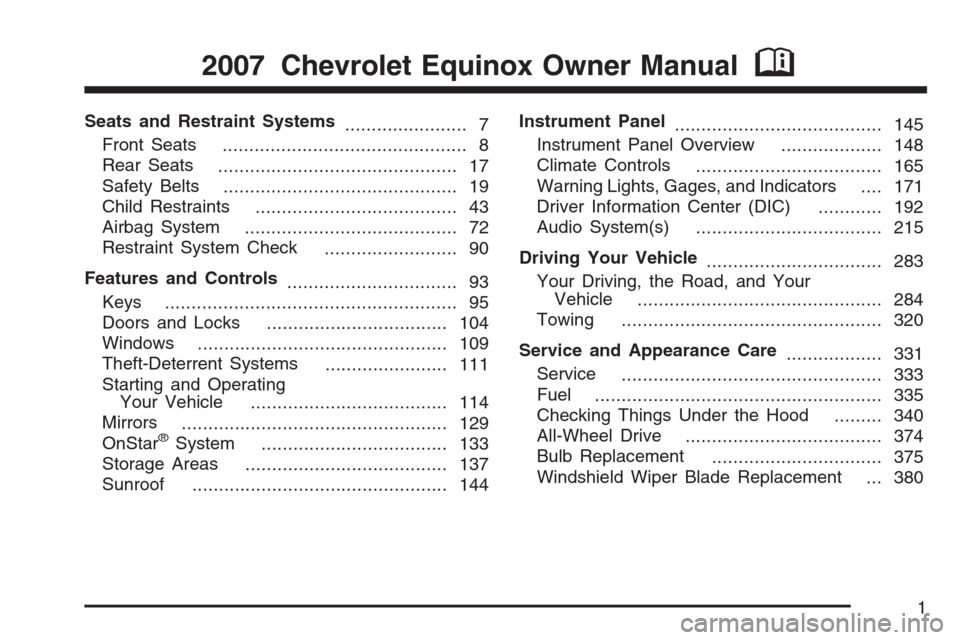
Seats and Restraint Systems
....................... 7
Front Seats
.............................................. 8
Rear Seats
............................................. 17
Safety Belts
............................................ 19
Child Restraints
...................................... 43
Airbag System
........................................ 72
Restraint System Check
......................... 90
Features and Controls
................................ 93
Keys
....................................................... 95
Doors and Locks
.................................. 104
Windows
............................................... 109
Theft-Deterrent Systems
....................... 111
Starting and Operating
Your Vehicle
..................................... 114
Mirrors
.................................................. 129
OnStar
®System
................................... 133
Storage Areas
...................................... 137
Sunroof
................................................ 144Instrument Panel
....................................... 145
Instrument Panel Overview
................... 148
Climate Controls
................................... 165
Warning Lights, Gages, and Indicators
.... 171
Driver Information Center (DIC)
............ 192
Audio System(s)
................................... 215
Driving Your Vehicle
................................. 283
Your Driving, the Road, and Your
Vehicle
.............................................. 284
Towing
................................................. 320
Service and Appearance Care
.................. 331
Service
................................................. 333
Fuel
...................................................... 335
Checking Things Under the Hood
......... 340
All-Wheel Drive
..................................... 374
Bulb Replacement
................................ 375
Windshield Wiper Blade Replacement
... 380
2007 Chevrolet Equinox Owner ManualM
1
Page 101 of 492
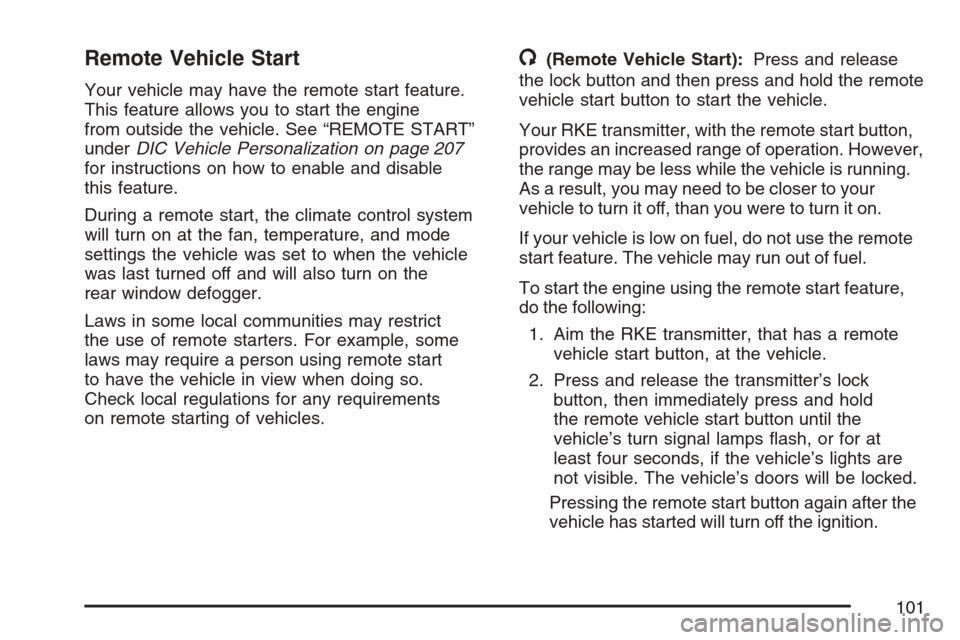
Remote Vehicle Start
Your vehicle may have the remote start feature.
This feature allows you to start the engine
from outside the vehicle. See “REMOTE START”
underDIC Vehicle Personalization on page 207
for instructions on how to enable and disable
this feature.
During a remote start, the climate control system
will turn on at the fan, temperature, and mode
settings the vehicle was set to when the vehicle
was last turned off and will also turn on the
rear window defogger.
Laws in some local communities may restrict
the use of remote starters. For example, some
laws may require a person using remote start
to have the vehicle in view when doing so.
Check local regulations for any requirements
on remote starting of vehicles.
/(Remote Vehicle Start):Press and release
the lock button and then press and hold the remote
vehicle start button to start the vehicle.
Your RKE transmitter, with the remote start button,
provides an increased range of operation. However,
the range may be less while the vehicle is running.
As a result, you may need to be closer to your
vehicle to turn it off, than you were to turn it on.
If your vehicle is low on fuel, do not use the remote
start feature. The vehicle may run out of fuel.
To start the engine using the remote start feature,
do the following:
1. Aim the RKE transmitter, that has a remote
vehicle start button, at the vehicle.
2. Press and release the transmitter’s lock
button, then immediately press and hold
the remote vehicle start button until the
vehicle’s turn signal lamps �ash, or for at
least four seconds, if the vehicle’s lights are
not visible. The vehicle’s doors will be locked.
Pressing the remote start button again after the
vehicle has started will turn off the ignition.
101
Page 118 of 492
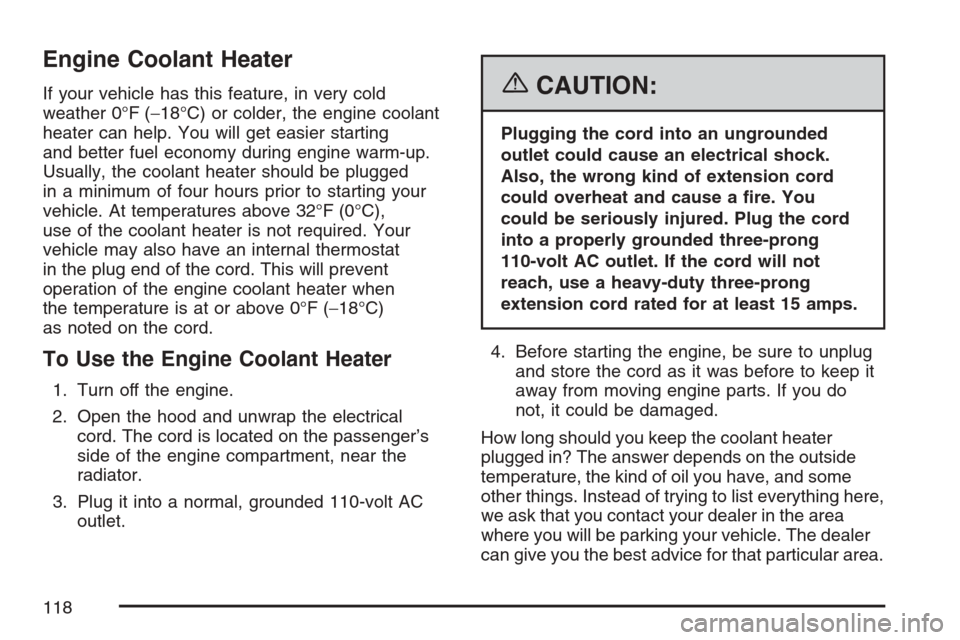
Engine Coolant Heater
If your vehicle has this feature, in very cold
weather 0°F (−18°C) or colder, the engine coolant
heater can help. You will get easier starting
and better fuel economy during engine warm-up.
Usually, the coolant heater should be plugged
in a minimum of four hours prior to starting your
vehicle. At temperatures above 32°F (0°C),
use of the coolant heater is not required. Your
vehicle may also have an internal thermostat
in the plug end of the cord. This will prevent
operation of the engine coolant heater when
the temperature is at or above 0°F (−18°C)
as noted on the cord.
To Use the Engine Coolant Heater
1. Turn off the engine.
2. Open the hood and unwrap the electrical
cord. The cord is located on the passenger’s
side of the engine compartment, near the
radiator.
3. Plug it into a normal, grounded 110-volt AC
outlet.
{CAUTION:
Plugging the cord into an ungrounded
outlet could cause an electrical shock.
Also, the wrong kind of extension cord
could overheat and cause a �re. You
could be seriously injured. Plug the cord
into a properly grounded three-prong
110-volt AC outlet. If the cord will not
reach, use a heavy-duty three-prong
extension cord rated for at least 15 amps.
4. Before starting the engine, be sure to unplug
and store the cord as it was before to keep it
away from moving engine parts. If you do
not, it could be damaged.
How long should you keep the coolant heater
plugged in? The answer depends on the outside
temperature, the kind of oil you have, and some
other things. Instead of trying to list everything here,
we ask that you contact your dealer in the area
where you will be parking your vehicle. The dealer
can give you the best advice for that particular area.
118
Page 121 of 492
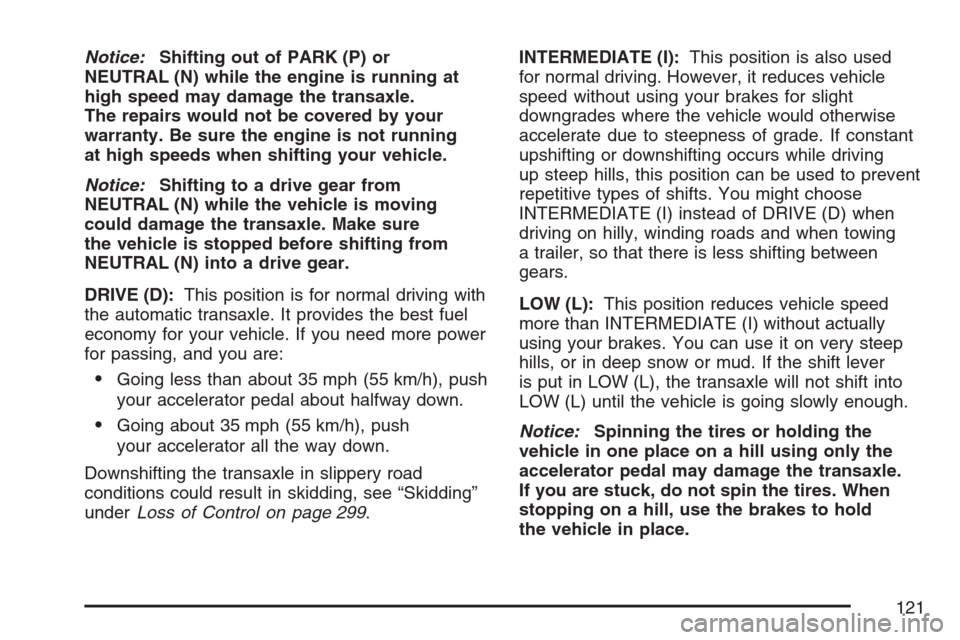
Notice:Shifting out of PARK (P) or
NEUTRAL (N) while the engine is running at
high speed may damage the transaxle.
The repairs would not be covered by your
warranty. Be sure the engine is not running
at high speeds when shifting your vehicle.
Notice:Shifting to a drive gear from
NEUTRAL (N) while the vehicle is moving
could damage the transaxle. Make sure
the vehicle is stopped before shifting from
NEUTRAL (N) into a drive gear.
DRIVE (D):This position is for normal driving with
the automatic transaxle. It provides the best fuel
economy for your vehicle. If you need more power
for passing, and you are:
Going less than about 35 mph (55 km/h), push
your accelerator pedal about halfway down.
Going about 35 mph (55 km/h), push
your accelerator all the way down.
Downshifting the transaxle in slippery road
conditions could result in skidding, see “Skidding”
underLoss of Control on page 299.INTERMEDIATE (I):This position is also used
for normal driving. However, it reduces vehicle
speed without using your brakes for slight
downgrades where the vehicle would otherwise
accelerate due to steepness of grade. If constant
upshifting or downshifting occurs while driving
up steep hills, this position can be used to prevent
repetitive types of shifts. You might choose
INTERMEDIATE (I) instead of DRIVE (D) when
driving on hilly, winding roads and when towing
a trailer, so that there is less shifting between
gears.
LOW (L):This position reduces vehicle speed
more than INTERMEDIATE (I) without actually
using your brakes. You can use it on very steep
hills, or in deep snow or mud. If the shift lever
is put in LOW (L), the transaxle will not shift into
LOW (L) until the vehicle is going slowly enough.
Notice:Spinning the tires or holding the
vehicle in one place on a hill using only the
accelerator pedal may damage the transaxle.
If you are stuck, do not spin the tires. When
stopping on a hill, use the brakes to hold
the vehicle in place.
121
Page 146 of 492
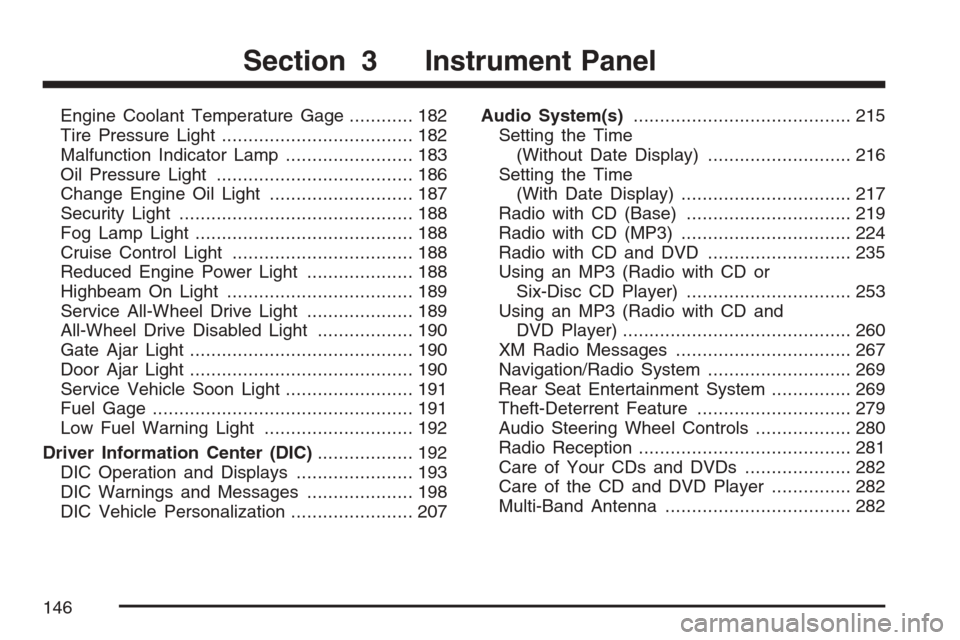
Engine Coolant Temperature Gage............ 182
Tire Pressure Light.................................... 182
Malfunction Indicator Lamp........................ 183
Oil Pressure Light..................................... 186
Change Engine Oil Light........................... 187
Security Light............................................ 188
Fog Lamp Light......................................... 188
Cruise Control Light.................................. 188
Reduced Engine Power Light.................... 188
Highbeam On Light................................... 189
Service All-Wheel Drive Light.................... 189
All-Wheel Drive Disabled Light.................. 190
Gate Ajar Light.......................................... 190
Door Ajar Light.......................................... 190
Service Vehicle Soon Light........................ 191
Fuel Gage................................................. 191
Low Fuel Warning Light............................ 192
Driver Information Center (DIC).................. 192
DIC Operation and Displays...................... 193
DIC Warnings and Messages.................... 198
DIC Vehicle Personalization....................... 207Audio System(s)......................................... 215
Setting the Time
(Without Date Display)........................... 216
Setting the Time
(With Date Display)................................ 217
Radio with CD (Base)............................... 219
Radio with CD (MP3)................................ 224
Radio with CD and DVD........................... 235
Using an MP3 (Radio with CD or
Six-Disc CD Player)............................... 253
Using an MP3 (Radio with CD and
DVD Player)........................................... 260
XM Radio Messages................................. 267
Navigation/Radio System........................... 269
Rear Seat Entertainment System............... 269
Theft-Deterrent Feature............................. 279
Audio Steering Wheel Controls.................. 280
Radio Reception........................................ 281
Care of Your CDs and DVDs.................... 282
Care of the CD and DVD Player............... 282
Multi-Band Antenna................................... 282
Section 3 Instrument Panel
146
Page 172 of 492
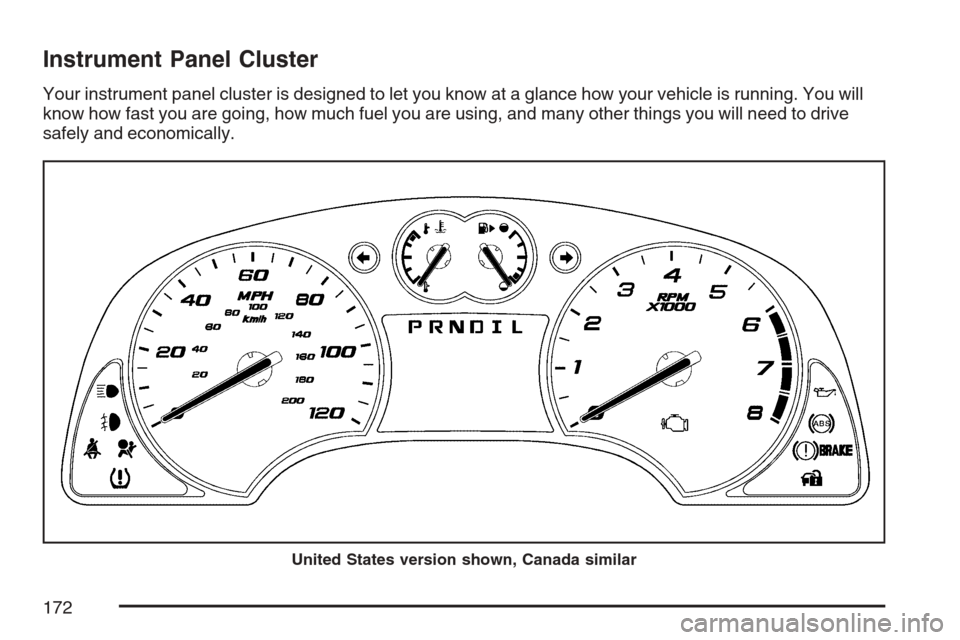
Instrument Panel Cluster
Your instrument panel cluster is designed to let you know at a glance how your vehicle is running. You will
know how fast you are going, how much fuel you are using, and many other things you will need to drive
safely and economically.
United States version shown, Canada similar
172
Page 183 of 492
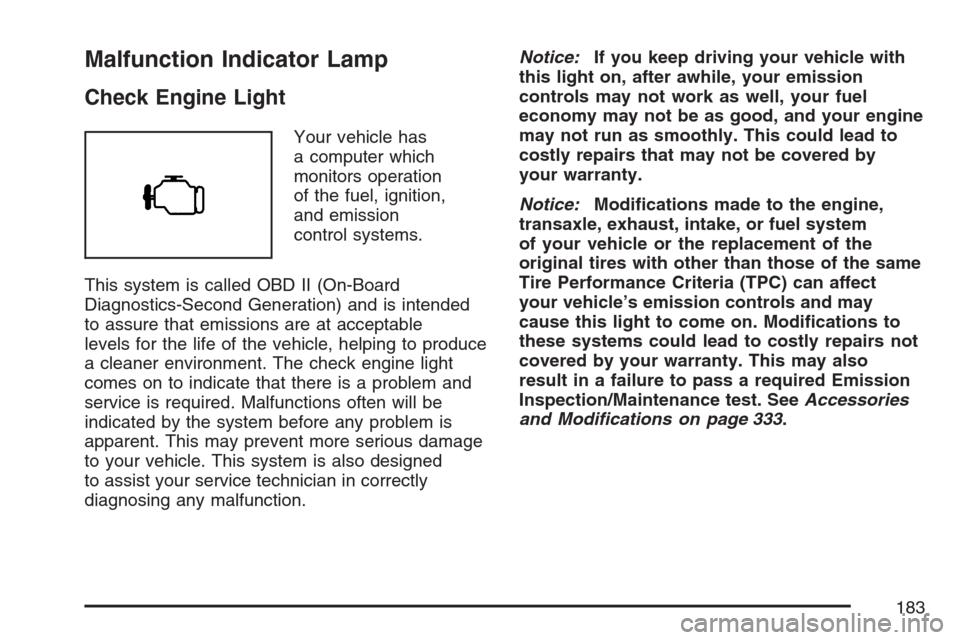
Malfunction Indicator Lamp
Check Engine Light
Your vehicle has
a computer which
monitors operation
of the fuel, ignition,
and emission
control systems.
This system is called OBD II (On-Board
Diagnostics-Second Generation) and is intended
to assure that emissions are at acceptable
levels for the life of the vehicle, helping to produce
a cleaner environment. The check engine light
comes on to indicate that there is a problem and
service is required. Malfunctions often will be
indicated by the system before any problem is
apparent. This may prevent more serious damage
to your vehicle. This system is also designed
to assist your service technician in correctly
diagnosing any malfunction.Notice:If you keep driving your vehicle with
this light on, after awhile, your emission
controls may not work as well, your fuel
economy may not be as good, and your engine
may not run as smoothly. This could lead to
costly repairs that may not be covered by
your warranty.
Notice:Modi�cations made to the engine,
transaxle, exhaust, intake, or fuel system
of your vehicle or the replacement of the
original tires with other than those of the same
Tire Performance Criteria (TPC) can affect
your vehicle’s emission controls and may
cause this light to come on. Modi�cations to
these systems could lead to costly repairs not
covered by your warranty. This may also
result in a failure to pass a required Emission
Inspection/Maintenance test. SeeAccessories
and Modifications on page 333.
183
Page 185 of 492
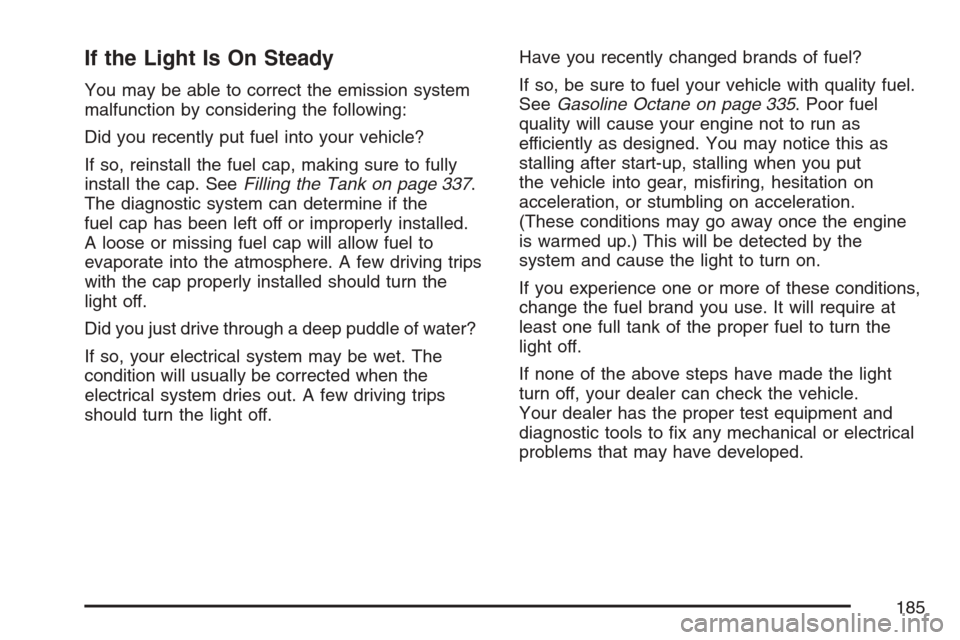
If the Light Is On Steady
You may be able to correct the emission system
malfunction by considering the following:
Did you recently put fuel into your vehicle?
If so, reinstall the fuel cap, making sure to fully
install the cap. SeeFilling the Tank on page 337.
The diagnostic system can determine if the
fuel cap has been left off or improperly installed.
A loose or missing fuel cap will allow fuel to
evaporate into the atmosphere. A few driving trips
with the cap properly installed should turn the
light off.
Did you just drive through a deep puddle of water?
If so, your electrical system may be wet. The
condition will usually be corrected when the
electrical system dries out. A few driving trips
should turn the light off.Have you recently changed brands of fuel?
If so, be sure to fuel your vehicle with quality fuel.
SeeGasoline Octane on page 335. Poor fuel
quality will cause your engine not to run as
efficiently as designed. You may notice this as
stalling after start-up, stalling when you put
the vehicle into gear, mis�ring, hesitation on
acceleration, or stumbling on acceleration.
(These conditions may go away once the engine
is warmed up.) This will be detected by the
system and cause the light to turn on.
If you experience one or more of these conditions,
change the fuel brand you use. It will require at
least one full tank of the proper fuel to turn the
light off.
If none of the above steps have made the light
turn off, your dealer can check the vehicle.
Your dealer has the proper test equipment and
diagnostic tools to �x any mechanical or electrical
problems that may have developed.
185
Page 191 of 492
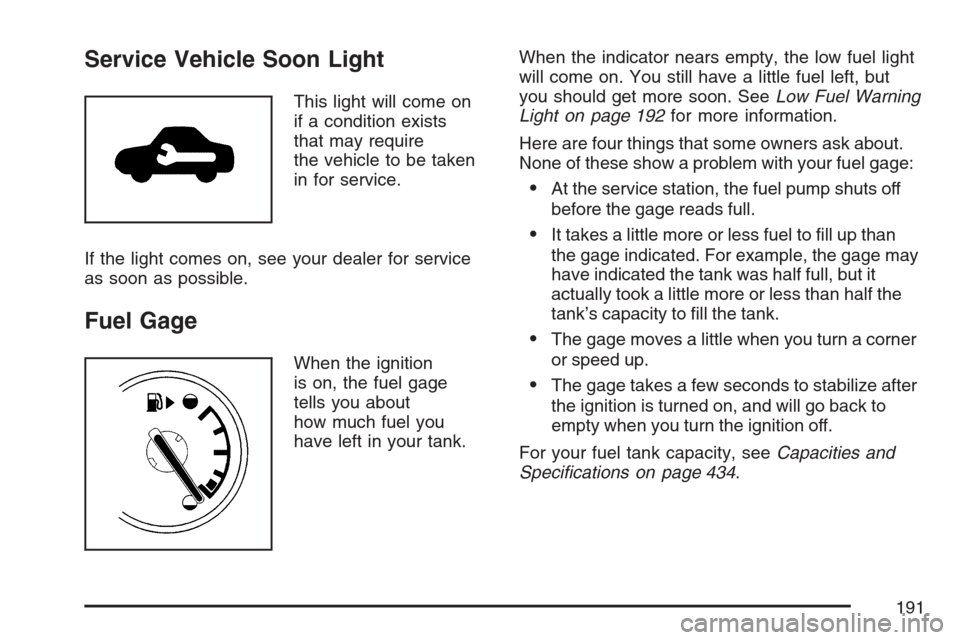
Service Vehicle Soon Light
This light will come on
if a condition exists
that may require
the vehicle to be taken
in for service.
If the light comes on, see your dealer for service
as soon as possible.
Fuel Gage
When the ignition
is on, the fuel gage
tells you about
how much fuel you
have left in your tank.When the indicator nears empty, the low fuel light
will come on. You still have a little fuel left, but
you should get more soon. SeeLow Fuel Warning
Light on page 192for more information.
Here are four things that some owners ask about.
None of these show a problem with your fuel gage:
At the service station, the fuel pump shuts off
before the gage reads full.
It takes a little more or less fuel to �ll up than
the gage indicated. For example, the gage may
have indicated the tank was half full, but it
actually took a little more or less than half the
tank’s capacity to �ll the tank.
The gage moves a little when you turn a corner
or speed up.
The gage takes a few seconds to stabilize after
the ignition is turned on, and will go back to
empty when you turn the ignition off.
For your fuel tank capacity, seeCapacities and
Speci�cations on page 434.
191
Page 192 of 492
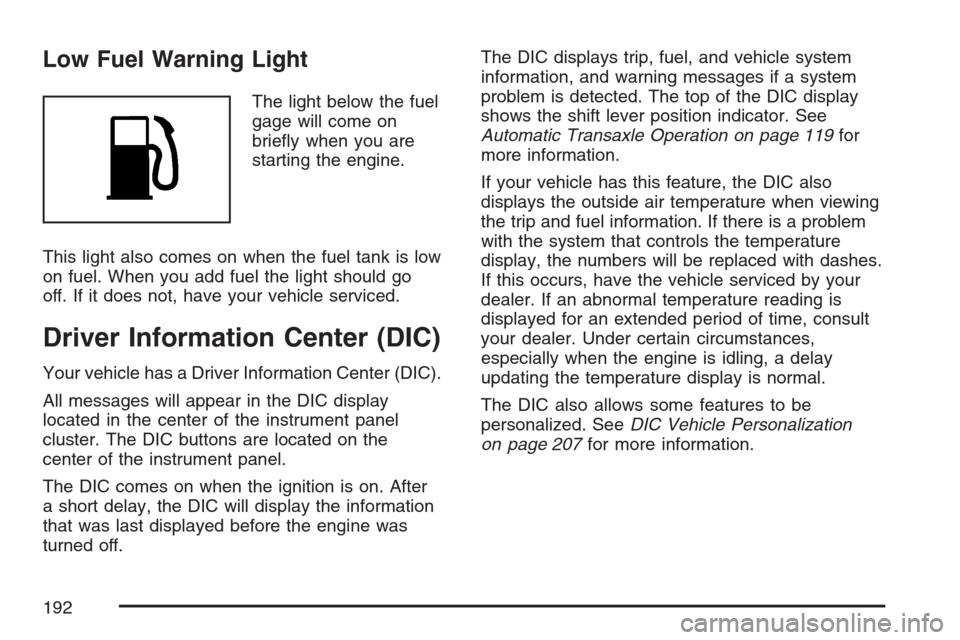
Low Fuel Warning Light
The light below the fuel
gage will come on
brie�y when you are
starting the engine.
This light also comes on when the fuel tank is low
on fuel. When you add fuel the light should go
off. If it does not, have your vehicle serviced.
Driver Information Center (DIC)
Your vehicle has a Driver Information Center (DIC).
All messages will appear in the DIC display
located in the center of the instrument panel
cluster. The DIC buttons are located on the
center of the instrument panel.
The DIC comes on when the ignition is on. After
a short delay, the DIC will display the information
that was last displayed before the engine was
turned off.The DIC displays trip, fuel, and vehicle system
information, and warning messages if a system
problem is detected. The top of the DIC display
shows the shift lever position indicator. See
Automatic Transaxle Operation on page 119for
more information.
If your vehicle has this feature, the DIC also
displays the outside air temperature when viewing
the trip and fuel information. If there is a problem
with the system that controls the temperature
display, the numbers will be replaced with dashes.
If this occurs, have the vehicle serviced by your
dealer. If an abnormal temperature reading is
displayed for an extended period of time, consult
your dealer. Under certain circumstances,
especially when the engine is idling, a delay
updating the temperature display is normal.
The DIC also allows some features to be
personalized. SeeDIC Vehicle Personalization
on page 207for more information.
192